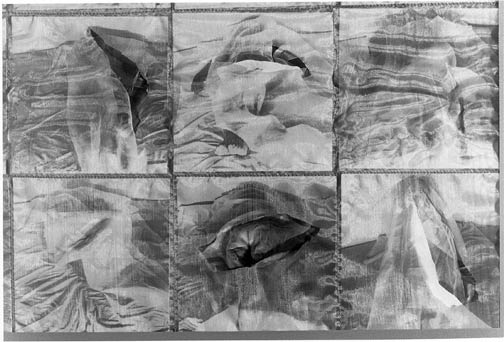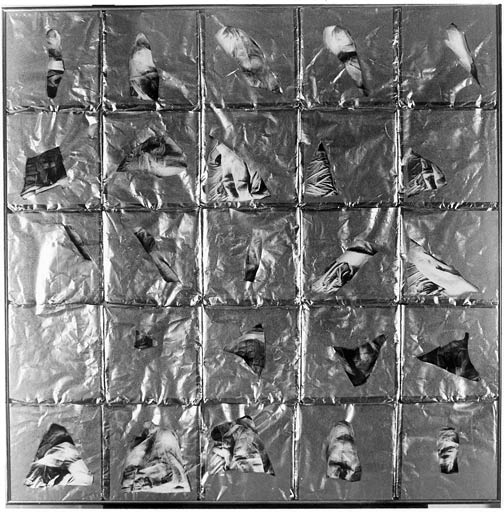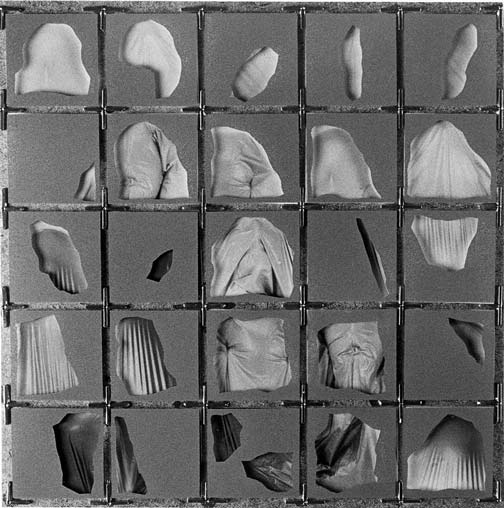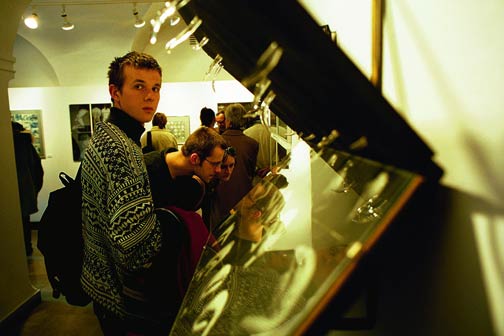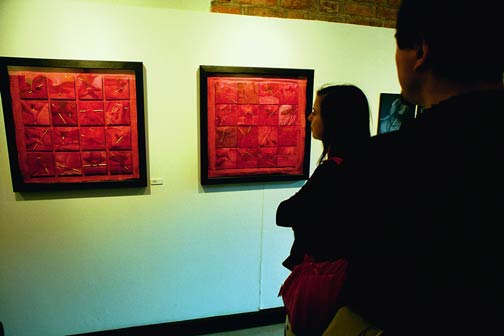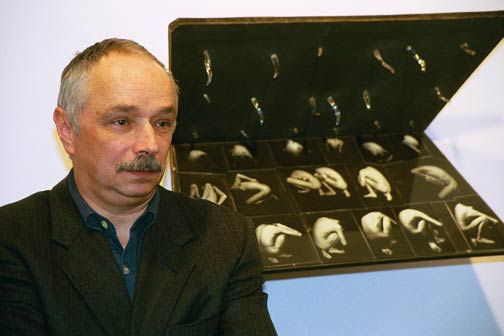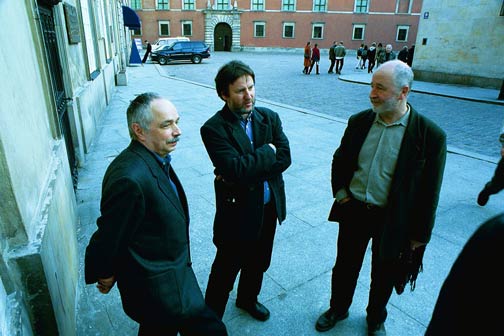Mala Gallery
8, Zamkowy Sq., Warsaw (Old Town)
April 3 - May 4, 2001

The works shown at the exhibition were made from negatives from the seventies. Double dating means that they were assembled presently. In cases when I was the model my wife Barbara (Magda) Falender was replacing me behind the lens. The negatives employed in the works "Reeds" and "Straps" were made by her. She made them as studies for her sculptures: "Source", "Plentitude" and "Night". The toned prints were made in the seventies as my gloss to the Magda's art. They were never shown before. Now I consider them to be expression of artistic union with the woman I love and admire. Grzegorz Kowalski
Grzegorz Kowalski: "Dream (layered)", 1975/2000
from: "Photographic objects" exhibition in Mala Gallery ZPAF-CSW, April 2001
Grzegorz Kowalski: "Dream", 1975/1998
from: "Photographic objects" exhibition in Mala Gallery ZPAF-CSW, April 2001
Grzegorz Kowalski: "Masks", 1978/2000,
from: "Photographic objects" exhibition in Mala Gallery ZPAF-CSW, April 2001
Arranging the world's matter
OMPLEX and extermely innerly rich creative work of Grzegorz Kowalski is a phenomenon still not properly recognized, what seems to be a kind of paradox in view of this artist's exceptional position in Polish art. His works escape attempts of any typical or stylistical classification. This exhibition adds another problem, the problem of time and chronology since we look at works that were practically made twice. The first time was in the mid-seventies when negatives were made, their conception was designed and variants of works were planned. The second time was recently when the artist was preparing these works in order to show them. But it is not a fact of great importance since Kowalski already included in the idea of his work an open, variant character of its realization.
"Photographic objects" resulted form very particular experiments carried out by Kowalski since the early seventies. "I am making photographic images of people and things - comments upon his works the artist himself - dozen or so or tens of photographs of persons and things intended to be put together in sets that I call tableaux - when they refer to people or collections - when they refer to things. The people sit for me after being molested or asked by me or after negotiations - when they expect to get something in return. I have to have permission to photograph them in a situation that seems to be or perahps is inconvenient or embarassing or offends their self-esteem". Sessions initiated by Kowalski required not exactly posing but a sort of participation in an event after which photographic recording was left. These action led to a radical change in relations between the artist and model and to the opening of the work to the participant of the event and to the inscribing him / her into work's structure. After years the artist certified: "events occuring between two persons force them both to cross barriers of intimacy, untouchability and privacy." This transgressive character of the process initiated by the artist was an attempt to recognize reality in multiplicity of its revelations, multiformity, inadequate formation, fragmentation. Photography proved to be the best medium to this purpose. It provides - as Kowalski defines - "presence of the third eye" which allows to see what the artist - perhaps - would hesitate even to think of. "To built a dam for imagination - he is asking himself -To forbid sinful thoughts. It is unfeasible. The judgement can only to be made within myself." His works show us his way of judging for himself. Their discourse about human body and its sexuality is a discourse about freedom and constraint, it is firm, open and creative pronouncement in favour of "the divine plan of free will".
Photographic sessions, seances or actions were constituting this stage of creation during which something that is the most essential and transitory at the same time was released. Negatives that recorded an "aura" of the event served to built a new form, "coherent and adequate to the idea". The "photographic objects" are in this respect very mature and very well "done" formally, e.g. "Dream" (1975) in which we feel almost tangibly straticulate character of this phenomenon or "Reeds" (1976?) referring to the space of repression and torture but also to the banality of erotism. The works of Kowalski, considering the period of their origination, are marked by unusual formal innovation in application and modification of photographic techniques.
In the work of Kowalski everything that composes the matter of life is brought under control and subjected to the process of arranging, description. Kowalski collects traces, memories and remainders left by man. Perhaps above all these are reminders left by himself, reminders of his existence in the world. He records and preserves them. And at the same time his works mean incessant transgression, rejection of form, questioning of recognized principles and determinants.
Also I can see some nostalgic element in Kowalski's work although it may not be a proper word. I think we should speak instead about specific "post-coital sadness" - such an irrational anxiety that goes together with fulfilment.
Waldemar Baraniewski
Opening of G. Kowalski's exhibition in Mala Gallery, April 3rd, 2001. Photo Arek Scichocki/GW
Opening of G. Kowalski's exhibition in Mala Gallery, April 3rd, 2001. Photo Arek Scichocki/GW
Opening of G. Kowalski's exhibition in Mala Gallery, April 3rd, 2001. Photo Arek Scichocki/GW
RZEGORZ KOWALSKI is one of personalities of Polish art scene whose importance is not sufficiently appreciated. He was long since connected with so called alternative art movement (Repassage Gallery in Warsaw). He was curator of many exhibitions (e.g. remarkable exhibition "Magi and Mystics" in the Centre for Contemporary Art). From many years he inspires Polish art life and takes active part in it. In his studio at the Warsaw's Academy of Fine Arts and under his direction there studied many artists who now take the lead in contemporary art scene. Grzegorz Kowalski besides being the prominent and exacting teacher is first and foremost an artist whose work is not sufficiently known to the wider public.
The aim of this exhibition is to make up for this and to remind, partly at least, of the artist's quests - in which photographic techniques played the leading role - dated to the seventies.
Marek Grygiel
Grzegorz Kowalski at opening of his exhibition "Photographic objects" in Mala Gallery ZPAF-CSW, April 3rd, 2001. Photo Arek Scichocki/GW
Grzegorz Kowalski
was born on January 10, 1942 in Warsaw. In 1959 - 1965 he studied at the Department of Sculpture in the Academy of Fine Arts in Warsaw and got his education in the studios of Jerzy Jarnuszkiewicz and Oskar Hansen. In 1965 he graduated and began his career as a teacher in the Academy of Fine Arts.
Grzegorz Kowalski's work was influenced by Oskar Hansen's theory of Open Form. The first period of his creative activity (from 1965-1970) coincided with the boom of conferences on art and numerous events in the open air, which had scientific as well social aims in their programme (e.g. the symposium in Puławy in 1966, the Second Biennial Exhibition of Spatial Forms in Elbląg in 1967, the International Symposium of Sculptors in Mexico in 1968, the symposium "Wrocław 70"). His first individual exhibition was an installation called "Pocket" and was presented in Foksal Gallery in Warsaw.
In the second period of Grzegorz Kowalski's art (1972 - 1980), which is mainly connected with Repassage Gallery in Warsaw, two main lines in his creative work may be differentiated. One line is exemplified by works in the form of photographic tableaux which reported on interpersonal activities or their projects: Horizontal composition (from 1972), a series of photographic objects (1972 - 74), Shoes (1975), Chair (1974 - 75). The other line of his creative activity includes actions 'sensu stricto': Copy (1977), Compilation (1977), Grass (1978), People/Animals (1978), Could You and/or Would You Like to Treat Me as an Object? (1979), Would You Like to Return to Your Mother's Womb? (1981-1988). In the works belonging to these both lines the artist was including invited participants into the sphere of his work as partners.
The principle of Grzegorz Kowalski's artistic work is being reflected in his educational method. Its mature development in the form of interaction classes with students called Individual/Common Area (1981/1982) defines an important line of the third period of the artist's creative activity (1980 onward). Objects-collections Gloves (1975-1985) and Suitcases (1986-1991) are continuation of reflections upon material and spiritual existence of man.
Maryla Sitkowska
In front of Mala Gallery in Warsaw during opening of "Photographic objects" exhibition - left to right: the artist, prof. Grzegorz Kowalski, exhibition curator, Marek Grygiel i Director of Centre for Contemporary Arts, Wojciech Krukowski. Photo Arek Scichocki/GW
back to FOTOTAPETA's front page
Copyright © 1997-2025 Marek Grygiel / Copyright for www edition © 1997-2025 Zeta-Media Inc.
07 - 04 - 2001
